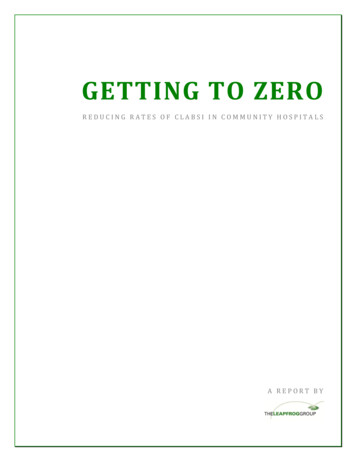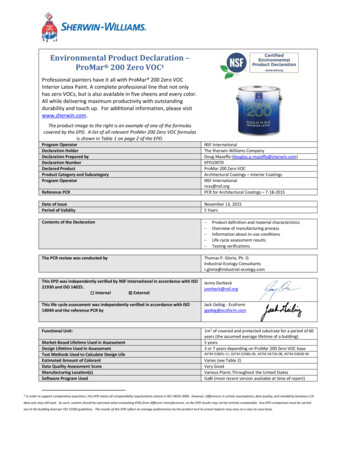
Transcription
GETTING TO ZEROREDUCING RATES OF CLABSI IN COMMUNITY HOSPITALSA REPORT BY
PROJECT STAFFFrances S. Margolin, project director, The Leapfrog GroupWilliam Robinson, The Leapfrog GroupGuy D’Andrea, Discern ConsultingAllison Doyle, Discern ConsultingThe Leapfrog Group (www.leapfroggroup.org) is a Washington, DC-based not-for-profit organizationfounded a decade ago by public and private purchasers of employee health benefits to work forimprovements in health care safety, quality, and affordability. 2011 The Leapfrog Group. All Rights Reserved. Getting to Zero2
EXECUTIVE SUMMARYCentral-line associated bloodstream infections, commonly referred to by the acronym CLABSI, are seriousand all-too often lead to long-term illness or even death. CLABSIs are also expensive, costing as much as 40,000 per incident. Today many hospitals across the country have begun to target CLABSIs, especially intheir ICU’s, as an important problem that they can tackle successfully. Many have adopted the checklist andapproach used by the team from Johns Hopkins University, led by Peter Pronovost, in what is widely knownas the Keystone Project.To begin understanding how hospitals achieved outstanding results in eliminating CLABSI, we conducted asmall study of four typical community hospitals, all of which had achieved zero or very low CLABSI rates intheir ICUs. Hospital staff members, including ICU staff (physicians and nurses), quality control, infectioncontrol, materials management, and administration, were interviewed using an open-ended interviewguide during visits to the four hospitals.Results showed that all four hospitals used a checklist and guidelines promulgated by AHRQ and CDC:1.2.3.4.5.Hand hygieneMaximal sterile barrier precautionsChlorhexidine skin antisepsisAppropriate insertion site selectionPrompt removal of unnecessary cathetersOne of the important questions addressed in this study was the role of organized and/or evidence-basedapproaches to the reduction of central-line associated infections, and how hospitals tailored thoseorganized approaches. The approaches to reducing infections varied in formality and sophistication. One ofthe hospitals used CLABSI reduction as one of their first attempts to employ Six Sigma methodology forquality improvement. Another participated in the Keystone project. The third hospital was prompted bytheir corporate parent to address CLABSI. Hospital leaders adapted materials that were handed down fromthe system to fit their institution. The fourth hospital did not have a manufacturing-driven or statewideinitiative that promoted its success, but it developed a successful infection control program that startedwith the CDC guidelines and was driven by teamwork.This study identified three primary content domains associated with the achievement of zero or very lowCLABSI rates: (1) use and application of evidence-based procedures for central line insertion andmaintenance, (2) culture and environment, and (3) maintenance efforts at each hospital. 2011 The Leapfrog Group. All Rights Reserved. Getting to Zero3
All four hospitals in this study adopted and followed the AHRQ and CDC guidelines, but significant effortswere needed to encourage adherence to the measures and to monitor staff performance. Although clinicalstaff members were aware of the literature, process changes did not take effect until hospital policy wasrewritten. It was important that all members of the care team had input into the process. Each of thehospitals developed specific methods for educating staff and measuring results with performance data. Allfour hospitals now use an insertion checklist, and the checklists document the procedure. Tracking theCLABSI data to document improvement helped to achieve necessary changes in culture, as did supportfrom the hospital's medical leadership.To complement the insertion checklist, each of the hospitals analyzed the organization of supplies anddevices required for insertion. All had purchased or developed central line kits or carts to hold all therequired supplies. The kits ensure that the supplies are easily portable and comprehensive, and contributeto the standardization of the insertion process. The central line kits or carts all contained similar supplies:protective provider barriers (cap, gloves, gown), protective patient barrier, chlorhexidine, catheters, andother devices and tools, including IV medication delivery antimicrobial technology (all employing silver asthe antimicrobial agent). We also found consistency in who places central lines and a commitment by all ofthe hospitals’ physicians to follow best practices for placing lines.Respondents commented on the importance of the hospital’s internal and external communityrelationships and the obligation to the patients who place their trust in the hospital's care. All the hospitalsused a culture of safety survey or questionnaire to gain a better understanding of their successes and areasof improvement opportunity. The involvement of all levels of staff, especially senior administrative andclinical leadership, is critical to a successful initiative roll-out. All of the hospitals integrated clinical andadministrative staff into the improvement process. Staff indicated that buy-in goes hand-in-hand with staffownership—if the staff participates in the development and execution of the initiative, then they are moreapt to follow the guidelines and produce positive results. This buy-in relates directly to a common themefound across all four hospitals—ownership of the process, patient, and outcomes.Interview subjects at every hospital spoke about the culture of communication and collaboration. All fourhospitals emphasized the value and judgment of the clinical nursing staffs and their relationship with theICU physician staffs. Over time, the dynamic between nurses and physicians focused on increasedcollaboration and mutual respect. All the hospitals reported that the overall dynamic improved as a resultof the hospitals’ ability to celebrate successes. 2011 The Leapfrog Group. All Rights Reserved. Getting to Zero4
Respondents at all four hospitals emphasized the importance of not only initial education but also on-goingtraining. All four had implemented continuous education beyond a standard orientation for both clinicalstaff and physicians. In all four hospitals, comprehensive, multidisciplinary rounds were conducted forevery ICU patient; although this was time-intensive, physicians and ICU nurses at the hospitals said thatconsistent, comprehensive care contributed to better patient outcomes, and it also enabled opencommunications across staff members.Respondents at all four sites stated that it is a constant challenge to keep infections at bay. Someestablished additional practices to help ensure proper line insertion and line maintenance, such asminimizing the number of central lines placed. Others re-examined and adjusted their care processes afterhaving an infection following months of being infection-free. To date, these hospitals have tried a variety ofmaintenance practices on their own because the published literature focuses more on insertion processesand sterility practices rather than on-going central line maintenance. To ensure proper maintenance, somehospitals have adapted the concept of the insertion kit to central-line dressing changes.This was a small study of community hospitals and should not be generalized beyond that context.Additional research examining other types of hospitals is needed, as is further study of how hospitalsmaintain lines once inserted. Nevertheless, our findings do support the idea that local hospitals can and doundertake successful quality improvement efforts and can and do provide high-quality care to theirfamilies, friends, and neighbors. 2011 The Leapfrog Group. All Rights Reserved. Getting to Zero5
AN URGENT NEEDEnter the phrase “central line bloodstream infections” into Google, and you get more than 66,000 results.Why this proliferation of information? These infections have been targeted by the health care industry—doctors, hospital quality control staff, the government’s Agency for Healthcare Research and Quality(AHRQ) , the Centers for Medicare and Medicaid Services (CMS)—and rightfully so. Central-line associatedbloodstream infections, commonly referred to by the acronym CLABSI, are serious and all-too often lead tolong-term illness or even death. CLABSIs are also expensive, costing as much as 40,000 per incident.CLABSIs were once thought to be inevitable—not that every patient with a catheter inserted to allow easyadministration of drugs would develop an infection, but that some number would, and that it was notpreventable.But then one hospital—Johns Hopkins in Baltimore—did a study in its Intensive Care Unit (where mostpatients with central lines are cared for), and was able to reduce the number of CLABSIs. The Hopkinsresearchers, led by Dr. Peter Pronovost, took their process to the Michigan Keystone Center for PatientSafety & Quality, to see if their results could be replicated more widely. The Keystone ICU Project, as itcame to be known, had impressive results. It helped decrease CLABSI rates significantly in 103 IntensiveCare Units across the state of Michigan. After 18 months, the rate of CLABSI infections decreased by 66%.1The most recent study shows that the Keystone ICU Project “was associated with a significant decrease inhospital mortality [of patients aged 65 or older] compared with the surrounding area.”2Today many hospitals across the country have begun to target CLABSIs, especially in their ICU’s, as animportant problem that they can tackle successfully. Many have adopted the checklist and approach usedby Pronovost’s team. As a result, we see the 66,000 Google entries.But what we don’t see is the stories behind the studies. What were the inner workings of the hospitals inthe CLABSI studies? And what about those hospitals that were not part of a study and have taken up thegoal of reducing CLABSI on their own? How did the hospitals effect change? We know that it’s not enough“Johns Hopkins Safety Team Works to Eliminate Bloodstream Infections in the Nation and the World.” February 25, eases/Johns Hopkins Safety Team Works to Eliminate Bloodstream Infections in the Nation and the World1Lipitz-Snyderman, Allison, Steinwachs, Donald, Needham, Dale M., Colantuoni, Elizabeth,Morlock, Laura L., and Pronovost, Peter J,“Impact of a statewide intensive care unit quality improvement initiative on hospital mortality and length of stay: Retrospectivecomparative analysis,” BMJ 2011:342:d219 doi:10.1136/bmj.d2192 2011 The Leapfrog Group. All Rights Reserved. Getting to Zero6
to just tell people—especially professionals with a long history and investment in “the way we do thingsaround here”—to change. What are the ingredients that allow some hospitals to adopt new processes, newtools, and new relationships among colleagues?As Dr. Pronovost has said (speaking of comparative effectiveness research in general), "What we need toalso do is say, 'How can I be sure that this therapy is also going to work when I try it in a communityhospital or outside of the study?' "3 Arnold Milstein,M.D., a national quality expert, concurs, noting the valueof “comparing different treatment application methods . That's where you get into the question of nowthat you've figured out the right treatment, how do you make sure it's implemented effectively, safely,patient-pleasingly and without wasting resources?"4 In other words, it is not enough to determine a "bestpractice" in health care; the hard part is successfully implementing that best practice in a large number ofhospitals.As a first step toward finding out just how hospitals achieved outstanding results in eliminating CLABSI, weconducted a small study of four typical hospitals—the kind you find in most American communities, thekind where most of us will be treated should we need hospital care. Community hospitals are the heart andsoul of American medicine, and it is critical that they be able to continue to provide first-class care to theirpatients—our families and neighbors. We are hopeful that lessons learned from these hospitals that havebeen successful in reducing their rates of CLABSI will help provide guidance in their efforts to tackle otherpatient safety initiatives.This report summarizes the results of this preliminary study. We begin with background on the history ofinterest in CLABSI, including the work of Pronovost and his team. We then describe what we did and howwe did it. The heart of the report is the results of what we found in four extraordinary yet very ordinaryAmerican community hospitals. We conclude with some next steps that we might take.3Quoted in Aston, Geri, “Comparative Effectiveness (Why Does It Matter to You?),“ H&HN Online, accessed 2/22/2011.4Aston, G., cited above. 2011 The Leapfrog Group. All Rights Reserved. Getting to Zero7
BACKGROUNDIn 2000, the prestigious Institute of Medicine released a groundbreaking report, To Err Is Human: Buildinga Safer Health System, which forced the health care industry to acknowledge the problem of patient safety.5This report was the first widespread publication of two shocking numbers: studies had indicated that atleast 44,000 Americans die each year as a result of preventable medical errors, and the number may be ashigh as 98,000. Since then, hospitals and other health care providers have increasingly identified andattacked specific quality-of-care issues, with varying degrees of success. A further concern: many hospitalstackle problems on their own, "reinventing the wheel, "with little or no sharing of results across systems orinstitutions, or sometimes even across departments within a single hospital.Over the decade following To Err Is Human and its sequel, Crossing the Quality Chasm6, concern aboutimproving quality of health care and reducing the related costs of poor care was picked up by the public,particularly patient advocacy groups and the payor community. In 2008, the Centers for Medicare andMedicaid Services (CMS) announced that it would no longer pay for adverse events that a hospital canprevent by following evidence-based guidelines. CMS focused on the reduction of 10 adverse events thatare widespread and high-cost—medical errors such as the retention of foreign objects after surgery andinfections such as vascular catheter-associated infections, which includes central-line associatedbloodstream infections (CLABSI).7 Many private-sector health plans have followed suit by implementingpayment policies designed to incentivize providers to reduce errors and infections and improve outcomes.8One particular set of problems that has received significant attention from providers and payors of healthcare, including the government, is hospital-acquired infections, including central-line associatedbloodstream infections (CLABSI). Reducing the incidence of CLABSI has both economic and humanimplications for all health care stakeholders. Approximately 48% of all patients admitted to an IntensiveCare Unit (ICU)—by definition, the sickest, most vulnerable patients—have a central line inserted to5Institute of Medicine, To Err Is Human: Building a Safer Health System ,L.T. Kohn, J.M. Corrigan, and M.S. Donaldson, eds.Washington, DC, 2000.6Institute of Medicine, Crossing the Quality Chasm: A New Health System for the 21 st Century. Washington, DC. 2001.Center for Medicare and Medicaid Services (CMS). Accessed October 14, 2010.http://www.cms.gov/HospitalAcqCond/06 Hospital-Acquired Conditions.asp#TopOfPage7The Commonwealth Fund. “A Conversation with Dana Gelb Safran About Getting the Incentives Right: The Blue Cross Blue Shieldof Massachusetts Alternative Quality Contract.” Quality Matters Newsletter. June/July rsation-with-DanaSafran.aspx8 2011 The Leapfrog Group. All Rights Reserved. Getting to Zero8
administer medications and obtain blood draws on a regular basis. Inserting a central line exposes the skinand body to the outside world and can provide easy access for bacteria to enter the bloodstream. Properinsertion and maintenance techniques are critical for successful outcomes. On average, there are 5.3central line infections per 1,000 catheter days as a result of many factors: prolonged hospitalization beforecatheterization, prolonged catheterization, microbial colonization at the insertion site, microbialcolonization of the catheter hub, and insertion site location, among others.9When a patient does develop a central-line associated bloodstream infection, the consequences are seriousand expensive. The patient will require treatment with antibiotics and prolonged hospitalization, usuallyfor an average of seven days.10 One study found that the average cost of care in the ICU ranges from 2,000to 3,000 per day,11 in addition to antibiotic treatment and additional care, which amounts to an averageadditional cost of 45,000 per patient for a CLABSI.12 Unfortunately, antibiotic treatment does not alwayslead to a successful outcome for patients. Data indicates a mortality rate of 18% for patients who developCLABSI.13As would be hoped, the field has developed and tested guidelines for preventing CLABSI. Specificguidelines have been set by the Agency for Healthcare Research and Quality (AHRQ), the Centers forDisease Control and Prevention (CDC), the Institute for Healthcare Improvement (IHI), and otherorganizations to help hospitals improve quality care for patients with central-lines.14 In addition toguidelines, CDC developed the National Healthcare Safety Network (NHSN) in 2005 as an internet-basedsurveillance system to collect patient safety data voluntarily reported by hospitals across the country.AHRQ provides educational resources and supports continued research on effective techniques to reduceMarschall, Jonas MD et al. “Strategies to Prevent Central Line-Associated Bloodstream Infections in Acute Care Hospitals.”Infection Control and Hospital Epidemiology. October 2008; 29: 0.1086/591059.910IHI ToolkitLuce, John M. and Gordon D. Rubenfeld. “Can Health Care Costs Be Reduced by Limiting Intensive Care at the End of Life?”American Journal of Respiratory and Critical Care Medicine. March 2002, Vol. 165: full/165/6/750#B8.11Kass, Nancy Sc.D. et al. “Controversy and Quality Improvement: Lingering Questions.” The Joint Commission Journal on Qualityand Patient Safety. June 2008: Vol 34, No 6. HI Toolkit. ownloads/01-central-lines-how-to-guide.pdfAHRQ guidelines can be found at http://www.ahrq.gov/about/annualconf10/hines milne/hines.HTM . CDC Guidelines can befound at htm. IHI guidelines can be found at “Prevention of CentralLine-Associated Bloodstream Infection.” http://www.ihi.org/NR/rdonlyres/ 01E7F0ED-EEDE-41BA-ABB0982405602158/0/cli.pdf14 2011 The Leapfrog Group. All Rights Reserved. Getting to Zero9
rates of CLABSI and other hospital-acquired infections. A notable national AHRQ-funded initiative, “On theCusp,” focuses on unit-based educational training and tools to reduce CLABSI in ICUs. AHRQ and the CDCrecommend the following quality measures to prevent CLABSI:151. Hand hygiene2. Maximal sterile barrier precautions3. Chlorhexidine skin antisepsis4. Appropriate insertion site selection5. Prompt removal of unnecessary cathetersIHI created the 100,000 Lives Campaign in 2005, with subsequent guides for focusing on specific qualityimprovements to reduce errors, infections, and poor outcomes using the concept of “bundles” of measures.IHI’s How-To Guide for the P
The Keystone ICU Project, as it came to be known, had impressive results. It helped decrease CLABSI rates significantly in 103 Intensive Care Units across the state of Michigan. After 18 months, the rate of CLABSI infections decreased by 66%.1 The most recent study shows that the Keystone I










